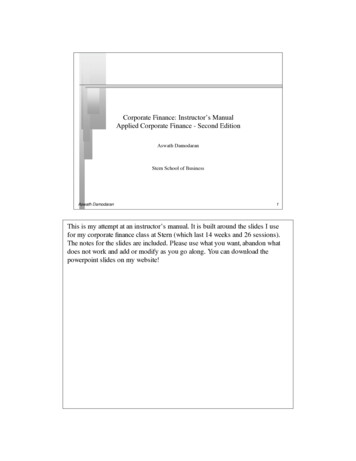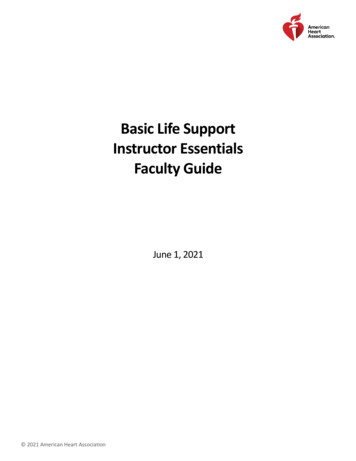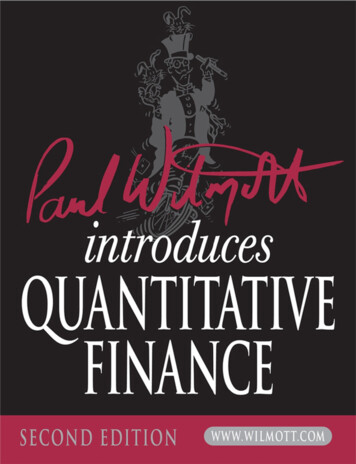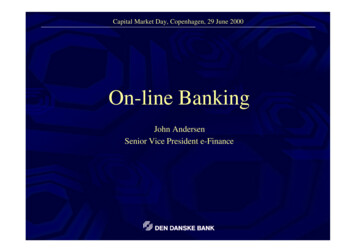
Transcription
Corporate Finance: Instructor’s ManualApplied Corporate Finance - Second EditionAswath DamodaranStern School of BusinessAswath Damodaran1This is my attempt at an instructor’s manual. It is built around the slides I usefor my corporate finance class at Stern (which last 14 weeks and 26 sessions).The notes for the slides are included. Please use what you want, abandon whatdoes not work and add or modify as you go along. You can download thepowerpoint slides on my website!
The Objective in Corporate Finance“If you don’t know where you are going, it does not matter how you getthere”Aswath Damodaran2
First Principles!Invest in projects that yield a return greater than the minimum acceptablehurdle rate. !!The hurdle rate should be higher for riskier projects and reflect the financing mixused - owners’ funds (equity) or borrowed money (debt)Returns on projects should be measured based on cash flows generated and thetiming of these cash flows; they should also consider both positive and negativeside effects of these projects.Choose a financing mix that minimizes the hurdle rate and matches the assetsbeing financed.If there are not enough investments that earn the hurdle rate, return the cash tothe owners of the firm (if public, these would be stockholders). The form of returns - dividends and stock buybacks - will depend upon thestockholders’ characteristics.Objective: Maximize the Value of the FirmAswath Damodaran3 This is the big picture of corporate finance. Tie in the course outline to the big picture. (I put session numbers on this pageto show when we will be doing what) Emphasize the common sense basis of corporate finance. Note that people havebeen running businesses, and some of them very well, for hundreds of yearsprior to the creation of corporate finance as a discipline. Talk about the three major components of corporate finance - the investment,financing and dividend decisions, and how corporate finance views thesedecisions through the prism of firm value maximization.
The Classical Viewpoint!!!!Van Horne: "In this book, we assume that the objective of the firm is tomaximize its value to its stockholders"Brealey & Myers: "Success is usually judged by value: Shareholders aremade better off by any decision which increases the value of their stake in thefirm. The secret of success in financial management is to increase value."Copeland & Weston: The most important theme is that the objective of thefirm is to maximize the wealth of its stockholders."Brigham and Gapenski: Throughout this book we operate on the assumptionthat the management's primary goal is stockholder wealth maximizationwhich translates into maximizing the price of the common stock.Aswath Damodaran4I picked four widely used books and quoted the “ value maximization” objectivestatement from each of the books to illustrate two points: Value maximization as an objective function is pervasive in corporatefinancial theory Not enough attention is paid to defending this objective function inmost corporate finance books. The assumption is that all readers willaccept this objective function, which is not necessarily true. It is also interesting that these four books also state the objective functionsdifferently - Van Horne as “ stockholders value maximization” , Brealey andMyers and Copeland and Weston as stockholder wealth maximization andBrigham and Gapenski as the maximization as the stock price. Question to ask : Are these objective functions equivalent? If not, which assumption is the least restrictive and which is the mostrestrictive? What are the additional assumptions needed to get from the least to the mostrestrictive objective functions?
The Objective in Decision Making!!!In traditional corporate finance, the objective in decision making is tomaximize the value of the firm.A narrower objective is to maximize stockholder wealth. When the stock istraded and markets are viewed to be efficient, the objective is to maximize thestock price.All other goals of the firm are intermediate ones leading to firm valuemaximization, or operate as constraints on firm value maximization.Aswath Damodaran5This is the answer to the question posed in the previous overhead.There are alternative objective functions (Maximize market share, maximizeearnings, maximize growth )These are intermediate objective functions - maximizing market share by itself isvaluable insofar as it increases pricing power and thus, potentially the marketvalue.
The Criticism of Firm Value Maximization!Maximizing stock price is not incompatible with meeting employeeneeds/objectives. In particular: !!- Employees are often stockholders in many firms- Firms that maximize stock price generally are firms that have treated employeeswell.Maximizing stock price does not mean that customers are not critical tosuccess. In most businesses, keeping customers happy is the route to stockprice maximization.Maximizing stock price does not imply that a company has to be a socialoutlaw.Aswath Damodaran6Open up the discussion to what arguments student might have or might haveheard about stock price maximization. The three that I have heard most often arelisted above.Stock price maximization implies not caring for your employees. Use arecent story of layoffs to illustrate this criticism (Eastman Kodakannounced it was laying of 15,000 employees and stock price jumped 3.50). Then note that this is the exception rather than the rule. AConference Board study from 1994 found that companies whose stockprices have gone up are more likely to hire people than one whose stockprices have gone down. Also note that employees, especially in high techcompanies, have a large stake in how well their company does becausethey have stock options or stock in the company.Note that customer satisfaction is important but only in the context thatsatisfied customers buy more from you. What would happen to a firmthat defined its objective as maximizing customer satisfaction?A healthy company whose stock price has done well is much more likelyto do social good than a company which is financially healthy. Again,note that there are social outlaws who might create social costs in thepursuit of stock price maximization (Those nasty corporate raiders.) butthey are the exception rather than the rule.
Why traditional corporate financial theory focuses onmaximizing stockholder wealth.!!!Stock price is easily observable and constantly updated (unlike othermeasures of performance, which may not be as easily observable, andcertainly not updated as frequently).If investors are rational (are they?), stock prices reflect the wisdom ofdecisions, short term and long term, instantaneously.The objective of stock price performance provides some very elegant theoryon: Aswath Damodaranhow to pick projectshow to finance themhow much to pay in dividends7Emphasize how important it is to have an objective function that is observableand measurable. Note that stock prices provide almost instantaneous feedback(some of which is unwelcome) on every decision you make as a firm.Consider the example of an acquisition announcement and the market reactionto it. Stock prices of the acquiring firm tend to drop in a significant proportionof acquisitions. Why might markets be more pessimistic than managers aboutthe expected success of an acquisition? Because the track record of firms onacquisitions is not very good.
The Classical Objective FunctionSTOCKHOLDERSHire & firemanagers- Board- Annual MeetingLend MoneyBONDHOLDERSMaximizestockholderwealthNo Social mationhonestly andon timeSOCIETYCosts can betraced to firmMarkets areefficient andassess effect onvalueFINANCIAL MARKETSAswath Damodaran8This is the utopian world. None of the assumptions are really defensible aswritten, and skepticism is clearly justified:Why do we need these assumptions? Since, in many large firms, there is a separation of ownership frommanagement, managers have to be fearful of losing their jobs and go outand maximize stockholder wealth. If they do not have this fear, they willfocus on their own interests. If bondholders are not protected, stockholders can steal from them andmake themselves better off, even as they make the firm less valuable. If markets are not efficient, maximizing stock prices may not haveanything to do with maximizing stockholder wealth or firm value. If substantial social costs are created, maximizing stock prices maycreate large side costs for society (of which stockholders are members).Note that corporate finance, done right, is not about stealing from other groups(bondholders, other stockholders or society) but about making the firm moreproductive and valuable.
What can go wrong?STOCKHOLDERSHave little controlover managersLend MoneyBONDHOLDERSManagers puttheir interestsabove stockholdersSignificant Social CostsManagersSOCIETYBondholders canSome costs cannot beget ripped offtraced to firmDelay badMarkets makenews ormistakes andprovidemisleading can over reactinformationFINANCIAL MARKETSAswath Damodaran9This is my worst case scenario: Stockholders have little or no control over managers. Managers,consequently, put their interests above stockholder interests. Bondholders who do not protect themselves find stockholdersexpropriating their wealth. Information conveyed to markets is noisy, biases and sometimesmisleading. Markets do not do a very good job of assimilating thisinformation and market price changes have little to do with true value. Firms in the process of maximizing stockholder wealth create largesocial costs.In this environment, stockholder wealth maximization is not a good objectivefunction.
I. Stockholder Interests vs. Management Interests!!In theory: The stockholders have significant control over management. Themechanisms for disciplining management are the annual meeting and theboard of directors.In Practice: Neither mechanism is as effective in disciplining managementas theory posits.Aswath Damodaran10In theory, stockholders are supposed to come to the annual meeting, and makeinformed judgments about whether they want to keep incumbent management inplace. The board of directors is supposed to protect the stockholders.
The Annual Meeting as a disciplinary venue!The power of stockholders to act at annual meetings is diluted by three factors Aswath DamodaranMost small stockholders do not go to meetings because the cost of going to themeeting exceeds the value of their holdings.Incumbent management starts off with a clear advantage when it comes to theexercise of proxies. Proxies that are not voted becomes votes for incumbentmanagement.For large stockholders, the path of least resistance, when confronted by managersthat they do not like, is to vote with their feet.11It is not irrational for small stockholders to not actively involve themselves in themanagement of firms, because it is not economical for them to do so.A significant percentage of proxies do not get turned in. In many firms, themanagers of the firm get the votes commanded by these proxies. That would bethe equivalent of having an election and allowing the incumbent to get the votesof anyone who does not vote.For a large stockholder like Fidelity Magellan, with its hundreds of holdings, itjust might not be feasible to be an active investor. Even CALPERS, which has ahistory of activism, has pulled back in recent years.The annual meeting is tightly scripted and run, making it difficult for dissidentstockholders to be heard. (In Japan, in the 1980s, trouble makers were hired toheckle stockholders who tried to ask managers tough questions.
Board of Directors as a disciplinary mechanismAswath Damodaran12This sounds judgmental and it is meant to be. Directors do not spend a greatdeal of time overseeing managers, and they are well paid.The pay shown here understates the true compensation that directors make fromother perks and benefits that they get (pensions, for instance).(These numbers are from the surveys done by Korn/Ferry, an executive searchfirm, and come from a BusinessWeek article looking at the board.)
The CEO often hand-picks directors.!!!The 1992 survey by Korn/Ferry revealed that 74% of companies relied onrecommendations from the CEO to come up with new directors; Only 16%used an outside search firm. While that number has changed in recent years,CEOs still determine who sits on their boards.Directors often hold only token stakes in their companies. The Korn/Ferrysurvey found that 5% of all directors in 1992 owned less than five shares intheir firms. Most directors in companies today still receive morecompensation as directors than they gain from their stockholdings.Many directors are themselves CEOs of other firms.Aswath Damodaran13This adds to why directors spend so little time on oversight. CEOs, left tothemselves, will seldom pick adversarial directors. Directors also make far moremoney from directorships than they do from owning stock in the firm. Notsurprisingly, they do not take the side of stockholders.A Wall Street Journal article, a few years ago, looked at the phenomenon ofCEOs sitting on each other’s boards. It is very difficult to see how they can beobjective in those cases.
Directors lack the expertise (and the willingness) to ask thenecessary tough questions.!!In most boards, the CEO continues to be the chair. Not surprisingly, the CEOsets the agenda, chairs the meeting and controls the information provided todirectors.The search for consensus overwhelms any attempts at confrontation.Aswath Damodaran14Harold Geneen who ruled ITT with an iron fist during the sixties when Ibuiltitself up through acquisitions, mentions in his memoirs that almost all decisions,during his tenure, that were made by the board were unanimous.CEOs almost always chair the board, and establish the agenda for what theboard discusses.
Who’s on Board? The Disney Experience - 1997Aswath Damodaran15This may be going back in time but it may help understanding Disney’s presentpredicament. This way Disney’ s board at the height of Michael Eisner’spowers.Note the number of insiders on the board. (Seven out of 16)Also note the presence of Mr. Eisner’s private attorney (Irwin Russell) and theprincipal of his child’s elementary school (Reveta Bowers) on the board.How independent was this board likely to be of Mr. Eisner?
The Calpers Tests for Independent Boards!Calpers, the California Employees Pension fund, suggested three tests in 1997of an independent board !Are a majority of the directors outside directors?Is the chairman of the board independent of the company (and not the CEO of thecompany)?Are the compensation and audit committees composed entirely of outsiders?Disney was the only S&P 500 company to fail all three tests.Aswath Damodaran16Calpers was one of the first institutional investors to pay attention to corporategovernance. Every year, Calpers lists the 10 companies that were the worstculprits when it came to putting managerial interests over stockholder interests.
Business Week piles on The Worst Boards in 1997.Aswath Damodaran17A poor board does not necessarily translate into a poorly managed firm. Forinstance, Disney and Coca Cola do not have highly rated boards but deliveredsuperior returns to stockholders over the period.As a stockholder, however, the fact that returns are good might not compensatefor the fact that you do not believe that managers are responsive to yourinterests. (At the Disney stockholder meetings in both 1996 and 1997, there wassubstantial stockholder dissension in spite of the fact that the stock hadperformed very well in both periods.)
!Application Test: Who’s on board?!Look at the board of directors for your firm. Analyze Aswath DamodaranHow many of the directors are inside directors (Employees of the firm, exmanagers)?Is there any information on how independent the directors in the firm are from themanagers?18You can usually find this information for your firm in the 14-DEF filing that allfirms in the US have to make with the SEC. If you have a non-US firm, thisbecomes more difficult to do. While you can usually find the names of thedirectors from the annual report, you may have a difficult time finding out thelinkages (and potential conflicts) these directors may have with the managers ofthe firm.
So, what next? When the cat is idle, the mice will play .!No stockholder approval needed . Stockholder Approval neededWhen managers do not fear stockholders, they will often put their interestsover stockholder interests Aswath DamodaranGreenmail: The (managers of ) target of a hostile takeover buy out the potentialacquirer's existing stake, at a price much greater than the price paid by the raider,in return for the signing of a 'standstill' agreement.Golden Parachutes: Provisions in employment contracts, that allows for thepayment of a lump-sum or cash flows over a period, if managers covered by thesecontracts lose their jobs in a takeover.Poison Pills: A security, the rights or cashflows on which are triggered by anoutside event, generally a hostile takeover, is called a poison pill.Shark Repellents: Anti-takeover amendments are also aimed at dissuading hostiletakeovers, but differ on one very important count. They require the assent ofstockholders to be instituted.Overpaying on takeovers19These actions could all suggest that managerial interests are being put overstockholder interests. (Some of these actions, though, may also increasestockholder wealth. Managers will, of course, always claim that these actions arein stockholders’ best interests)
Overpaying on takeovers!!!The quickest and perhaps the most decisive way to impoverish stockholders isto overpay on a takeover.The stockholders in acquiring firms do not seem to share the enthusiasm ofthe managers in these firms. Stock prices of bidding firms decline on thetakeover announcements a significant proportion of the time.Many mergers do not work, as evidenced by a number of measures. The profitability of merged firms relative to their peer groups, does not increasesignificantly after mergers.An even more damning indictment is that a large number of mergers are reversedwithin a few years, which is a clear admission that the acquisitions did not work.Aswath Damodaran20Managers of acquiring firms almost always make every acquisition sound like agood idea. Stockholders are more skeptical (as is evidenced by the behavior ofacquiring firm stock prices on the announcement of acquisitions).Stockholders must be right, on average, since many takeovers do not seem towork in terms on increasing stockholder wealth or making the firms moreefficient.(Good referencesThe Synergy Trap, Mark Sirower)
A Case Study: Kodak - Sterling Drugs!Eastman Kodak’s Great VictoryAswath Damodaran21Note the difference in stock price behavior of the target and bidding firms.Note also the symmetry between premium paid over the market price at SterlingDrugs ( 2.1 billion) and value lost at Kodak ( 2.2 billion). Kodak argued thatthis merger would create synergy and that was why they were paying thepremium. The market did not seem to see any synergy.
Earnings and Revenues at Sterling DrugsSterling Drug under Eastman Kodak: Where is the 000500019881989Revenue199019911992Operating EarningsAswath Damodaran22Where is the synergy?Profits essentially stagnated at Sterling after the Kodak acquisition. The rest ofthe drug industry reported an annual growth in earnings of 15% a year duringthis period.Why is synergy so hard to capture? Firms do not plan for it at the time of the acquisitions Culture shock Unrealistic assumptions (AT&T and NCR)
Kodak Says Drug Unit Is Not for Sale (NY Times, 8/93)!An article in the NY Times in August of 1993 suggested that Kodak was eager to shed its drug unit. !In response, Eastman Kodak officials say they have no plans to sell Kodak’s Sterling Winthrop drug unit.Louis Mattis, Chairman of Sterling Winthrop, dismissed the rumors as “massive speculation, which flies in the face of the statedintent of Kodak that it is committed to be in the health business.”A few months later Taking a stride out of the drug business, Eastman Kodak said that the Sanofi Group, a Frenchpharmaceutical company, agreed to buy the prescription drug business of Sterling Winthrop for 1.68 billion. Shares of Eastman Kodak rose 75 cents yesterday, closing at 47.50 on the New York Stock Exchange.Samuel D. Isaly an analyst , said the announcement was “very good for Sanofi and very good for Kodak.”“When the divestitures are complete, Kodak will be entirely focused on imaging,” said George M. C. Fisher, the company's chiefexecutive.The rest of the Sterling Winthrop was sold to Smithkline for 2.9 billion.Aswath DamodaranAs in the old Soviet Union, nothing is true until it is officially denied.23
!Application Test: Who owns/runs your firm?Look at: Bloomberg printout HDS for your firm! Looking at the top 15 stockholders in your firm, are top managers in your firmalso large stockholders in the firm?! Is there any evidence that the top stockholders in the firm play an active rolein managing the firm?Aswath Damodaran24You can also get this information from Yahoo! Finance by going into companyprofiles and clicking on institutional investors
Disney’s top stockholders in 2003Aswath Damodaran25Not a single individual investor in the list other than Roy Disney who was the15th largest stockholder Managers are not significant stockholders inDisney (and the same can be said for most large publicly traded firms).The response is not to give them options since owning options does not createthe same incentives as owning shares Consider the following scenarios:1. Managers are not significant stockholders in the firm: Significant potentialfor conflicts of interest between managers and stockholders.2. Individuals are significant stockholders in the firm as well as part of topmanagement. Usually, these are founder-owners of the firm and the firmstend to be younger firms or family run businesses that have recently madethe transition to publicly traded firms. Smaller potential for conflict betweenmanagers and stockholders, but potential for conflict between insidestockholders and outside stockholders.3. Trusts or descendants of owners are significant stockholders in the firm butare not an active part of incumbent management. Power that thesestockholders retain to replace managers reduces potential for conflict ofinterest but power is reduced as holdings get diluted among lots of familymembers.4. Another company is largest stockholder in firm. In this case, trace out whoowns stock in the other company .
A confounding factor: Voting versus Non-voting Shares Aracruz!Aracruz Cellulose, like most Brazilian companies, had multiple classes ofshares at the end of 2002. !The common shares had all of the voting rights and were held by incumbentmanagement, lenders to the company and the Brazilian government.Outside investors held the non-voting shares, which were called preferred shares,and had no say in the election of the board of directors. At the end of 2002,Aracruz was managed by a board of seven directors, composed primarily ofrepresentatives of those who own the common (voting) shares, and anexecutive board, composed of three managers of the company.Aswath Damodaran26When voting rights vary across shares, incumbent managers can consolidatetheir hold on a company with relatively small holdings. This reduces the powerthat stockholders have in these companies.Differences in voting rights are common outside the U.S. In Asia and LatinAmerica, incumbent managers or family members can control companies withrelatively small holdings with complete impunity.
Another confounding factor Cross Holdings!!In a cross holding structure, the largest stockholder in a company can beanother company. In some cases, companies can hold stock in each other.Cross holding structures make it more difficult for stockholders in any of thecompanies involved to Aswath Damodarandecipher what is going on in each of the individual companiesdecide which management to blame or rewardchange managers even if they can figure out who to blame.27Deutsche is the largest stockholder in Daimler Chrysler, the German automobilecompany, and Allianz, the German insurance company, is the largest stockholderin Deutsche.
II. Stockholders' objectives vs. Bondholders' objectives!!In theory: there is no conflict of interests between stockholders andbondholders.In practice: Stockholder and bondholders have different objectives.Bondholders are concerned most about safety and ensuring that they get paidtheir claims. Stockholders are more likely to think about upside potentialAswath DamodaranBondholders include all lenders (including banks). The actions listed abovetransfer wealth from them to stockholders.28
Examples of the conflict.!!!Increasing dividends significantly: When firms pay cash out as dividends,lenders to the firm are hurt and stockholders may be helped. This is becausethe firm becomes riskier without the cash.Taking riskier projects than those agreed to at the outset: Lenders baseinterest rates on their perceptions of how risky a firm’s investments are. Ifstockholders then take on riskier investments, lenders will be hurt.Borrowing more on the same assets: If lenders do not protect themselves, afirm can borrow more money and make all existing lenders worse off.Aswath Damodaran29In each of these cases, you are likely to see stock prices go up on the action andbond prices go down.
An Extreme Example: Unprotected Lenders?Aswath Damodaran30Nabisco’s bond price plummeted on the day of the LBO, while the stock pricesoared.Is this just a paper loss? (You still get the same coupon. Only the price haschanged)Not really. There is now a greater chance of default in Nabisco, forwhich you as a lender are not compensated.How could Nabisco’s bondholders have protected themselves?Put in a covenant that allowed them to turn the bonds into the firm in theevent of something like an LBO and receive the face value of the bond.(Puttable bonds)Make the coupon payments on the bond a function of the company’srating (Rating sensitive bonds)
III. Firms and Financial Markets!In theory: Financial markets are efficient. Managers convey informationhonestly and and in a timely manner to financial markets, and financialmarkets make reasoned judgments of the effects of this information on 'truevalue'. As a consequence !A company that invests in good long term projects will be rewarded.Short term accounting gimmicks will not lead to increases in market value.Stock price performance is a good measure of company performance.In practice: There are some holes in the 'Efficient Markets' assumption.Aswath Damodaran31An efficient market is one where the market price reflects the true value of theequity in the firm (and any changes in it). It does not imply perfection on thepart of markets, but it does imply a link between what happens to the stock priceand what happens to true value.
Managers control the release of information to the generalpublic!!Information (especially negative) is sometimes suppressed or delayed bymanagers seeking a better time to release it.In some cases, firms release intentionally misleading information about theircurrent conditions and future prospects to financial markets.Aswath Damodaran32Consider an example of Bre-X, which told markets that it had found one of thelargest gold reserves in the world in Indonesia in the early 1990s. In 1997, itwas revealed that there was no gold, and that the firm had salted the mine withgold to fool investors. When the news eventually came out, the stock pricedropped to zero.Bre-X was followed by 9 analysts, all of whom professed to be shocked by therevelation.
Evidence that managers delay bad news.DO MANAGERS DELAY BAD NEWS?: EPS and DPS Changes- 0%MondayTuesdayWednesday% Chg(EPS)ThursdayFriday% Chg(DPS)Aswath Damodaran33This study looked at thousands of earnings and dividend announcements,categorized by day of the week in the 1980s. Either bad things tend to happenon Fridays, or managers are trying to hold on to bad news until Friday. In fact,most of the bad news on Friday comes out after 4 pm, and markets have closed.Managers do not trust markets to not panic on bad news.This may explain a portion of the weekend effect - stock prices tend to go downon Mondays.
Some critiques of market efficiency.!!!!Prices are much more volatile than justified by the underlying fundamentals.Earnings and dividends are much less volatile than stock prices.Financial markets overreact to news, both good and bad.Financial markets are manipulated by insiders; Prices do not have anyrelationship to value.Financial markets are short-sighted, and do not consider the long-termimplications of actions taken by the firm.Aswath Damodaran34The Shiller effect - stock prices are much volatile than justified by looking at theunderlying dividends and other fundamentals - is debatable. While people oftenpresent anecdotal evidence on the phenomenon, they under estimate the volatilityof the underlying fundamentals.For every researcher who claims to find evidence that markets overreact, thereseems to be another researcher who finds evidence that it under reacts. And noone seems to be able to systematically make real money (as opposed tohypothetical money) on these supposed over or under reactions.Corporate strategists, like Michael Porter, argue that market prices are basedupon short term forecasts of earnings and do not factor in the long term.In markets outside the US, the argument is that prices are moved by insiders andthat they have no relationship to value.
Are Markets Short term?!Focusing on market prices will lead compa
Corporate Finance: InstructorÕs Manual Applied Corporate Finance - Second Edition Aswath Damodaran Stern School of Business This is my attempt at an instructorÕs manual. It is built around the slides I use for my corporate Þnance class at Stern (which last 14 weeks










